Ethereum
ROI ~5%Solana
ROI ~7%Cardano
ROI ~3.06%BNB
ROI ~2.5%Polygon
ROI ~4.2%Tron
ROI ~5%Cosmos
ROI ~16.14%Hedera
ROI ~0.7%Kava
ROI ~6.61%Near
ROI ~7.41%Zilliqa
ROI ~12%Band Protocol
ROI ~12.69%MultiversX
ROI ~7.49%Osmosis
ROI ~5.58%Atomic Wallet Token
ROI ~20%Terra Classic
ROI ~12%Terra LUNA
ROI ~7%Flare
ROI ~4.2%ICON
ROI ~10%Algorand
ROI ~0.63%Tezos
ROI ~5.8%Komodo
ROI ~5.1%VeChain
ROI ~1.63%Injective
ROI ~17%Cronos
ROI ~5.54%Akash Network
ROI ~14%Nibiru Chain
ROI ~29.70%LAVA
ROI ~156%Artificial Superintelligence Alliance
ROI ~9.5%4 steps to get your SOL rewards
Get wallet
Install the app on your system
Deposit crypto
Deposit SOL to your account
Stake crypto
Choose a validator and stake SOL
Claim Rewards
After 4 days period, you will get your rewards every 2 days.
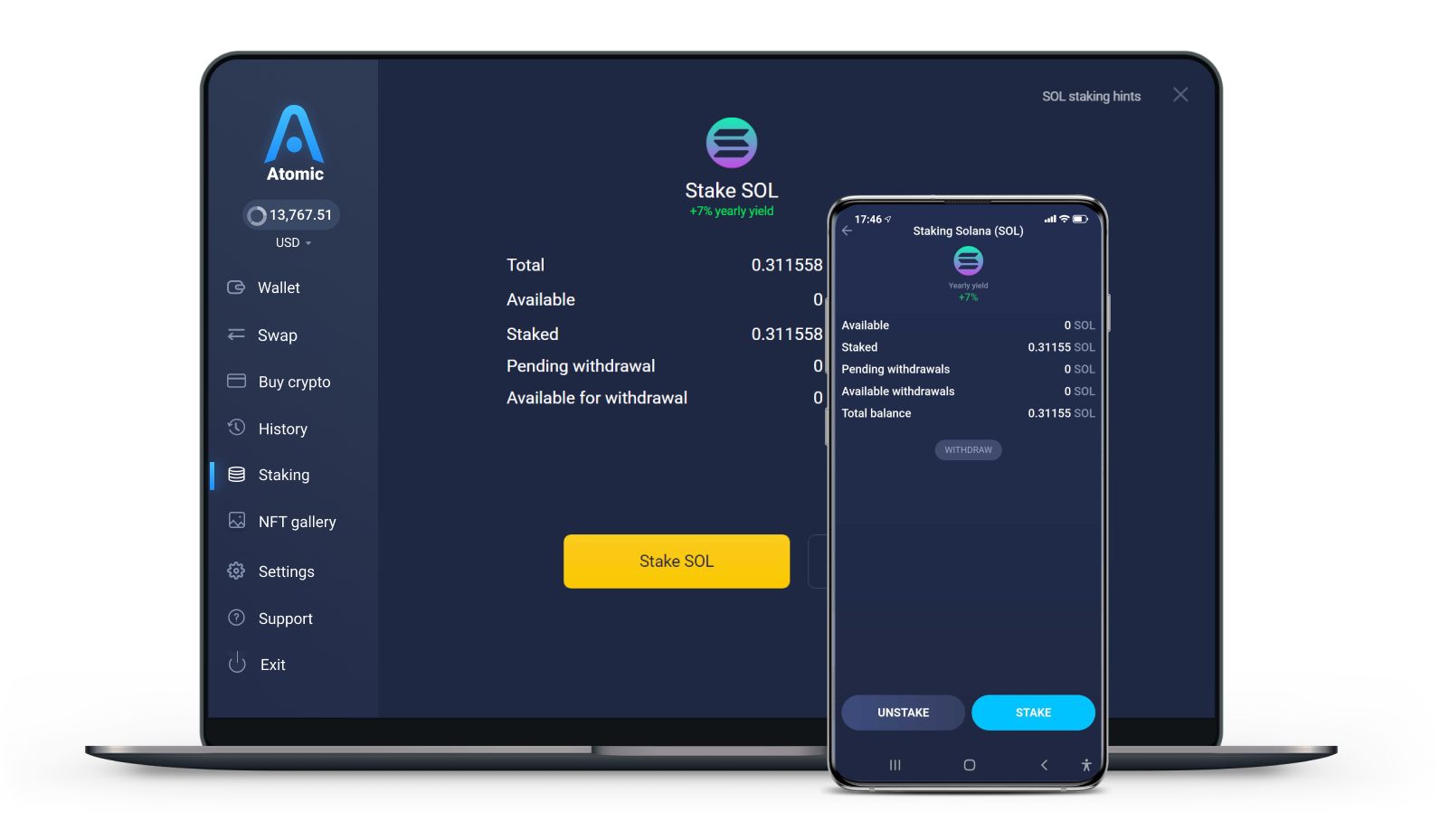
Solana (SOL) Staking Guide
A brief history of Solana
As of November 30th, 2020, there are more than 7,800 crypto-assets in existence, from first-generation market leaders like Bitcoin (BTC) to trail-blazing newcomers such as Solana (SOL).
Like most third-generation blockchains, Solana has been primarily designed to tackle the issue of scalability associated with networks such as BTC. As the amount of transactions on the blockchain grows, the stress of the network increases. To this end, it’s a web-scale blockchain that provides incredibly fast transactions, while keeping the transaction fees low. Solana network also features an additional layer of functionality that supports decentralized apps, marketplaces, and DeFi protocols.
Gotta go fast
Solana has become a high-performance blockchain since its inception in 2017. It currently is able to support an impressive TPS (transactions-per-second) of 50,000 and 400ms block times. To put this into context, the average TPS of the BTC blockchain is approximately 7, whereas Ethereum can handle roughly 20.
In terms of block times, the Bitcoin average is around 10 minutes (although this can vary significantly depending on overall demand), whereas the corresponding number for Ethereum is between 14 and 15 seconds overall. Even established payment systems such as Visa can only process between 1,500 and 2,000 transactions per second, which is considerably lower than the existing performance of the SOL network.
And even faster
Overall, Solana shows great numbers in all performance metrics of a blockchain. These numbers certainly support the overarching objective of the Solana blockchain and its founder Anatoly Yakovenko, who wanted to allow transaction throughput to scale proportionately with network bandwidth while satisfying the core properties of a blockchain; namely decentralization, security, and sustained scalability, providing access to decentralized finance to everyone who has an interest in it.
Going forward, the forecast is that the system will be able to support up to 710,000 TPS on a standard gigabit network, and a staggering 28.4 million TPS on a 40-gigabit network. This is based on optimal performance, of course, but it highlights the unique promise that Solana has in the existing crypto marketplace.
The tokenomics of the SOL coin
As we’ve already touched on, the Solana network was founded in 2017, while its initial mainnet went into operation in the third quarter of June 2018.
It subsequently launched on Mainnet Beta in March 2020, shortly after raising $1.76 million in funding through a public token auction hosted on CoinList. The native SOL tokens were sold at a price of $0.7768 at launch, in April, largely maintaining this level of value up until December 2020.
However, the value of the SOL tokens had been increasing incrementally during Q1 2021, reaching $19.47 on March 31st. This was triggered by the completion of several high-profile DeFi and dApp projects on its platform, while it was also heavily influenced by the wider crypto bull run. This trend continued throughout much of Q2, with the SOL coin peaking at $55.91 on May 18th.
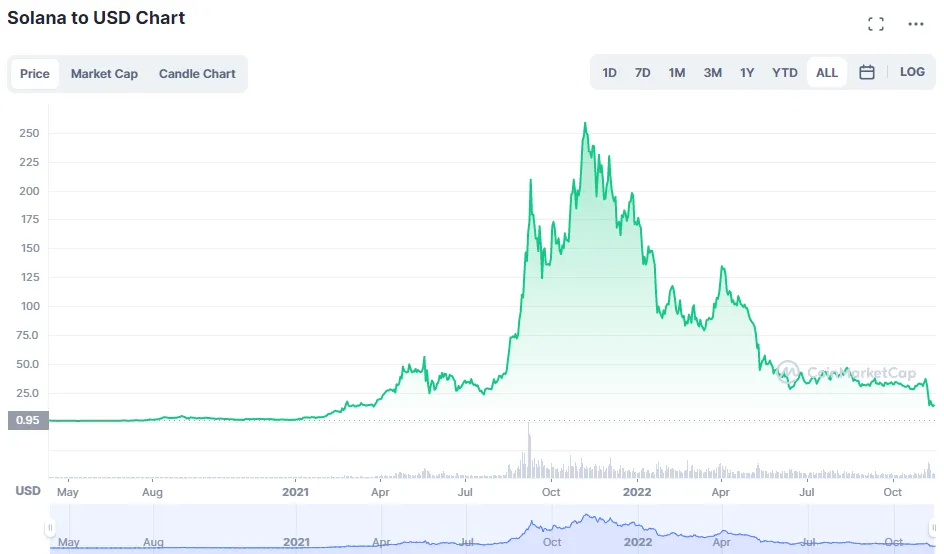
Of course, SOL lost some momentum throughout June, as the total market capitalization of all cryptocurrencies fell below $1.5 trillion and several assets crashed. Despite this, and sinking back to $24.69 on May 23rd, SOL has since rallied and remains competitively priced at $33.97 in the current marketplace.
Looking forward
Well, most price predictions are overwhelmingly positive for SOL. What’s more, treble-digital growth is forecast through 2033, with the asset’s price expected to reach $233.08 and $267.33 in 2025 and 2030 respectively.
This highlights the immense growth potential of the asset, which is built primarily on the blockchain’s incredible scalability, high performance, and rising demand within the burgeoning DeFi space.
Solana's Proof-of-Stake method
Another appealing feature of the Solana blockchain is its unique Proof-of-History concept, which works alongside a Proof-of-Stake (PoS) consensus mechanism.
Proof-of-Stake is a better consensus mechanism, as opposed to Proof-of-Work from the perspective of energy efficiency, and is capable of providing more options for punishing bad and malevolent actors. By utilizing the Proof-of-History consensus mechanism, users are able to create historical records that prove an event occurred during a specific moment in time.
To achieve this, it utilizes a high-frequency Verifiable Delay Function, which requires a number of sequential steps for the purpose of evaluation. Once an event (such as a transaction) has been evaluated, it will be given a unique hash and a count that can be transparently and efficiently verified.
The count serves as a timestamp that records the time when the transaction initially occurred, while every node within the network features a cryptographic clock that accurately organizes the chronological ordering of events. It’s this feature, that allows for particularly high throughput within the Solana network, without compromising on either the efficiency or security of individual transactions.
There’s no doubt that Proof-of-History is also an innovative way of improving the time spent confirming the order of transactions, and when combined with a Proof-of-Stake consensus mechanism, it makes the selection of a next block validator considerably easier.
Most importantly, individual validator nodes require less time to validate the order of transactions, tackling one of the primary issues with first-generation blockchains - scalability - with tremendous efficiency.
What is Solana staking?
Staking Solana means putting it to work, instead of just keeping it in your wallet. Staking your Solana is an opportunity to generate some passive income in the form of staking rewards. These staking rewards are paid out in SOL. In principle, Solana staking works relatively similarly to other staking other cryptos. To simplify, staking Solana means you investing your funds for the purpose of earning rewards.
When you stake SOL, you delegate a specific amount of it to a validator node. When doing so, you become a delegator, get a stake account, and your funds generate rewards for you. Individual validators approve and validate transactions on the Solana blockchain. Your Solana is 'locked' for the duration of the staking process and you get to earn rewards in the meantime. Only you get to decide how much SOL to stake and for how long.
Where do staking rewards come from?
You put your funds towards a certain validator which increases their chance of adding new transactions to the blockchain. The more SOL is delegated to a specific validator, the more transactions it gets to validate, thus making the validator more influential on the Solana network. When they get to do that, they receive crypto which they in turn distribute among the users that chose to stake their funds with them as staking rewards. The more transactions a validator gets to add to the blockchain, the more crypto they get. This is how you, as a delegator, can earn rewards from staking. Each validator node usually offers its own rewards rate.
Is staking Solana safe?
When staking Solana with a non-custodial wallet, such as Atomic Wallet, you get to keep complete control over your SOL tokens when they are staked. You can unstake them any time you want. Basically, it is the same as simply holding SOL in your wallet, when it comes to safety. You are still keeping your SOL in your wallet, but instead of just letting it collect dust, you put it to work and earn rewards.
Slashing
You should, however, keep in mind such a mechanism as slashing. This is a feature present on many Proof-of-Stake networks. In short, it means destroying a chunk of the total stake, delegated to a certain validator node. It is done as a corrective measure for malicious actions performed by a validator on a decentralized network. On the Solana network, the slashing mechanism is manual. If a malicious actor causes the entire network to stop, it can be slashed upon network restart.
Does Slashing affect me?
The feature is implemented to deter validators from undertaking such actions. When a portion of the stake is slashed, the validator loses some of its influence on the Solana network and, as a consequence, makes less money. That, in turn, means that the delegators earn less staking rewards.
Losing out on potential SOL rewards is not the only risk slashing poses for a delegator. If you staked your Solana tokens with a malicious validator, some of your staked Sol tokens might be lost when this validator is slashed. Slashing incentivizes SOL holders to carefully choose a validator to stake SOL with. One would be wise to delegate their tokens only to the most reputable and trustworthy Solana validators. It also incentivizes decentralization, making several delegations safer than putting all of your eggs in one basket and sticking to a single validator.
Why choose Atomic Wallet?
Atomic Wallet supports staking SOL fully. As a non-custodial wallet, your private keys will be stored and encrypted directly on your device, rather than in a centralized exchange. Keeping your private keys safe is of utmost importance. This minimizes the risk of your wallet being hacked, while also letting you keep complete control over your funds and transactions. All the background operations, like creating your stake account, are done automatically.
Currently, Atomic Wallet offers a 7% APY for staking SOL. APY is a great way to gauge the number of potential rewards. You can stake up to 100,000 coins between 24 hours and 12 months. So, if you staked the maximum amount of tokens for a year, you’d earn 7,000 coins with a total value of $102,620 (at the real-time price point of $14.66).
Atomic Wallet provides an easy and user-friendly way of keeping track of your staked funds, allowing you to start staking right away. And while many wallets support staking, Atomic Wallet also supports staking for a number of other assets, making managing your staked tokens from one main wallet that much easier for people who don't want to bother with several apps on their device and just want to enjoy some staking yields.
Staking SOL With Atomic Wallet
If you do decide to invest in SOL and get into Solana staking, leveraging its future price growth, Atomic Wallet provides a secure, decentralized, and custody-free storage option that can be accessed seamlessly through both desktop and mobile devices.
Things you need to know
Transaction fees. You’ll have to pay a network fee every time you want to stake or unstake your SOL. That's why we strongly recommend against staking all your funds. Make sure to leave enough SOL as your available balance so that you can pay the fees later. Otherwise, you won’t be able to unstake your deposit later on.
0.000038 SOL will be reserved on your address for future fees for claiming/unstaking transactions when you stake SOL. That means that these funds are still on your address and are available to send away or exchange, but are not available for staking. It is done to avoid a situation in which you accidentally stake all of your funds and are unable to unstake your coins or claim your rewards.
Your deposit will be locked. Your SOL deposit will be frozen throughout the staking period. This means your staked SOL won’t be counted toward your total balance. Also, you won’t be able to transfer or swap your staked tokens.
Staking and unstaking do not happen immediately. Staking and unstaking take several epochs (each epoch is around 3 days) to complete. Once you hit the Stake or Unstake button, your deposit will be frozen for several epochs. A fraction of the delegation becoming active (staked) or inactive (unstaked) at each epoch boundary after the button was clicked. More about it here.
Rewards. You'll start earning your SOL rewards in 2 epochs after your deposit was fully staked (which itself takes several epochs). After that, you'll receive your staking rewards automatically every epoch (~3 days).
Multiple delegations. Every time you stake some additional SOL, a new stake account will be created on the blockchain. Meaning, if you decide to stake additional SOL after you've already staked some, the newly added SOL will not be added to an already existing stake account.
For example, let's say you have 2 SOL staked. That's one stake account. Then you decide to stake additional 3 SOL. That's one more stake account. Now you have two stake accounts: one for 2 SOL and one for 3 SOL instead of having one stake account of 5 SOL. These are the rules of the SOL blockchain. If you wish to unstake your SOL, you will have to unstake each delegation individually. There is no way to unstake all of your stake accounts at once.
Deposit some Solana into your wallet
Once you’ve downloaded and launched Atomic Wallet on your device, the next step is to ensure that you have at least one SOL your available balance. You need to have some SOL to stake SOL.
Buying Solana
The first and probably the easiest way to deposit some Solana into your Atomic Wallet is to purchase it directly in the wallet. If you choose to go ahead with this route, you will need to provide some information, like your name, billing information, etc. You will also have to undergo a verification process, done by our partners to prevent fraud and money laundering. You can pay with a debit or a credit card. You can find a detailed, step-by-step guide on purchasing crypto in Atomic Wallet here. If you, by any chance, encounter any issues with your purchase, feel free to check out this guide.
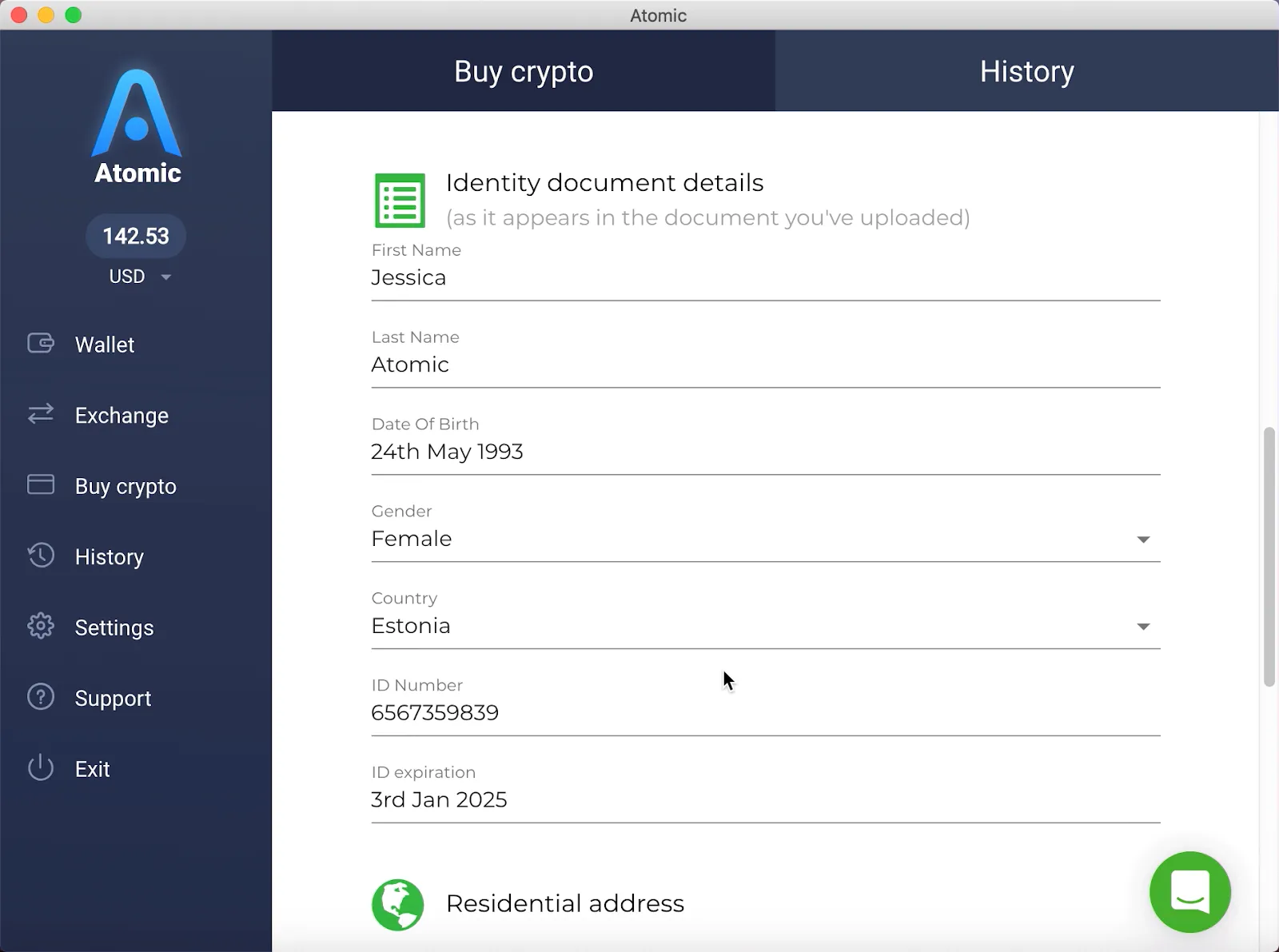
Swap another crypto for SOL
If you wish to stake Solana as soon as possible, but only have, let's say, Tezos, you ca swap it for SOL right in the wallet. Atomic Solana Wallet features a built-in swap that supports more than 500 crypto assets, while you can freely swap tokens without having to verify your identity or follow time-consuming ‘Know Your Customer (KYC) protocols. The swap also provides real-time prices for assets and cryptocurrency pairs, so you can ensure that you time the transaction to achieve the best possible value. A step-by-step guide on swapping assets in Atomic Wallet is available here.
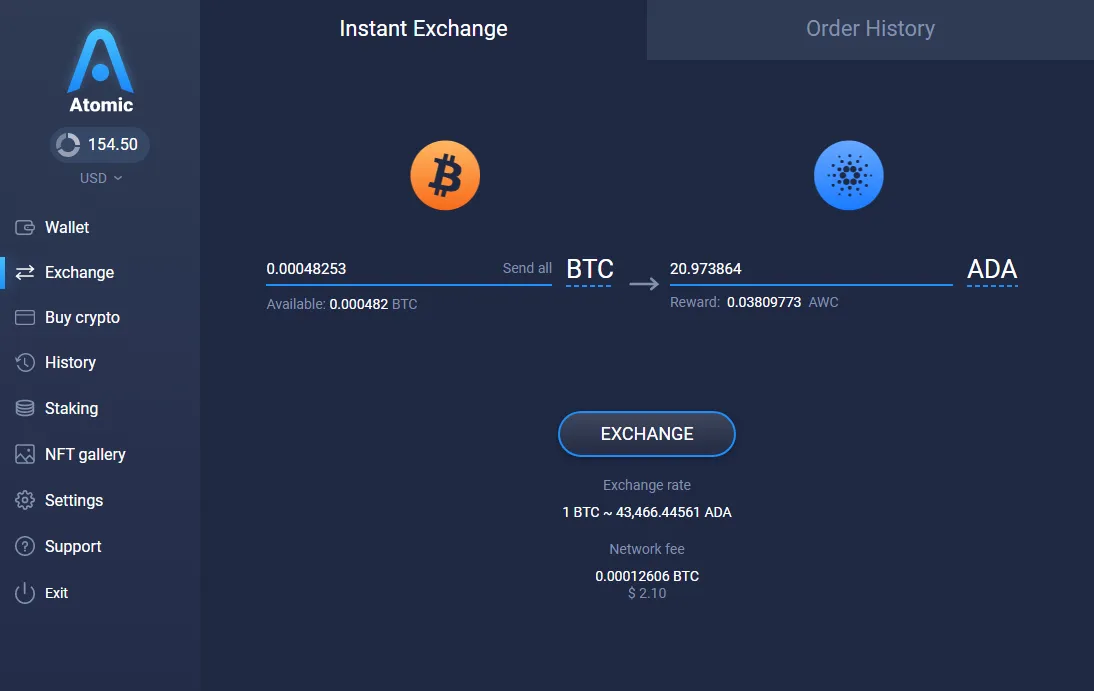
Send SOL to your Atomic Wallet
If you already have some SOL on another platform that doesn't support Solana staking, you can simply send it to your Atomic Solana Wallet and stake Solana right away. Depositing funds into Atomic is easy. Just find the coin you wish to deposit in your wallet, copy the address, and send funds to this address. Here's a more detailed breakdown of the process. Then you can stake Sol tokens.
Time to stake Sol tokens
Now that you have some Solana in your wallet, it's time to stake it. Staking SOL in Atomic Wallet is easy. First, let's get into the staking tab. Click 'Staking' on the left sidebar of your desktop wallet interface. If you're on mobile, the button is located in the bottom panel. The staking tab is a list of all the assets available for staking in Atomic Solana Wallet, along with their APYs. Here's an example:
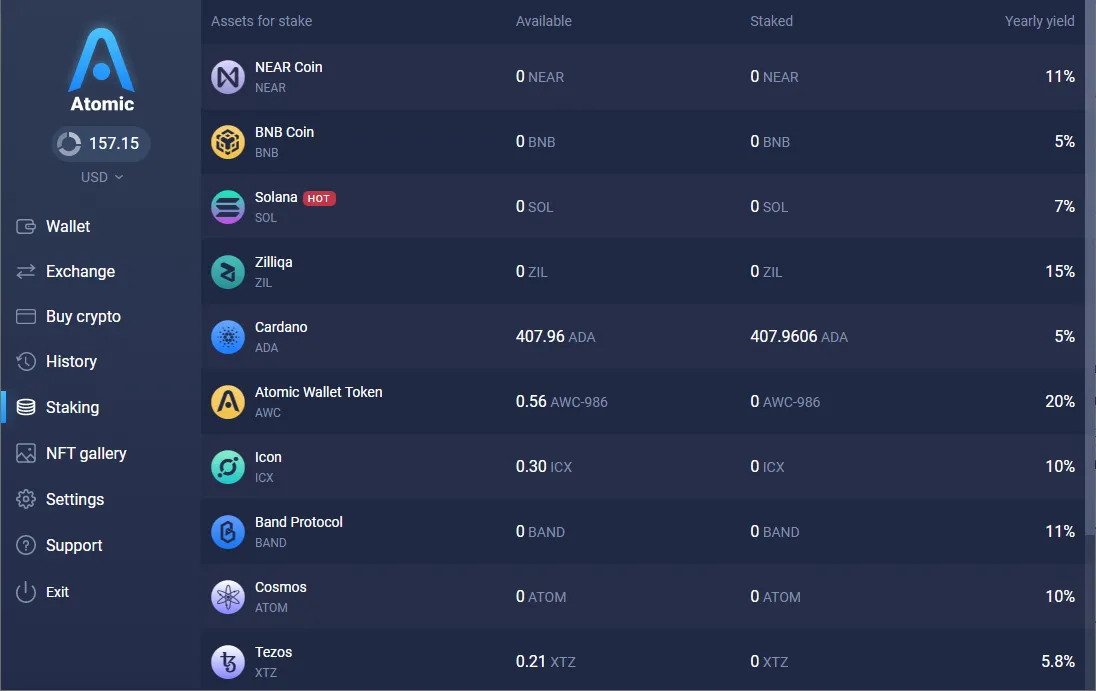
Select Solana from the list. You'll be presented with the SOL staking interface.
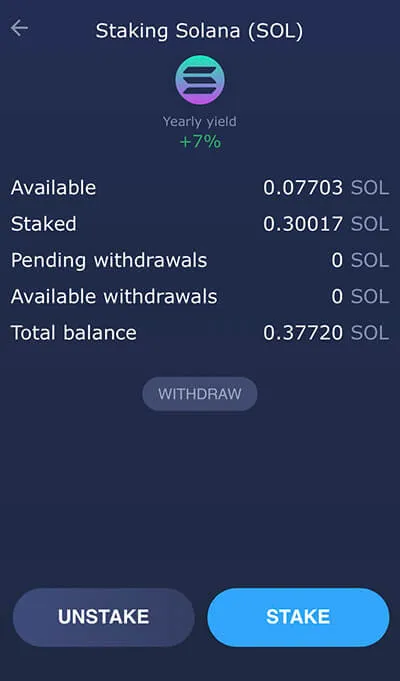
Available is the total amount of SOL you can stake at the moment.
Staked is your staked balance. I.e., the amount of SOL you already staked.
Pending withdrawals is your SOL that is in the process of unstaking. More on that later.
Available withdrawals is the SOL that has already gone through the unstaking process and can now be returned to you. We'll go into more detail about it later in this article.
Press the 'Stake' button at the bottom of the screen. Here you can choose the amount of SOL you want to stake. You'll also see how much you'll have to pay in transaction fees. Keep in mind, that Atomic Wallet does not charge any additional transaction fees from their users. Here, you can also choose a validator to delegate SOL to.
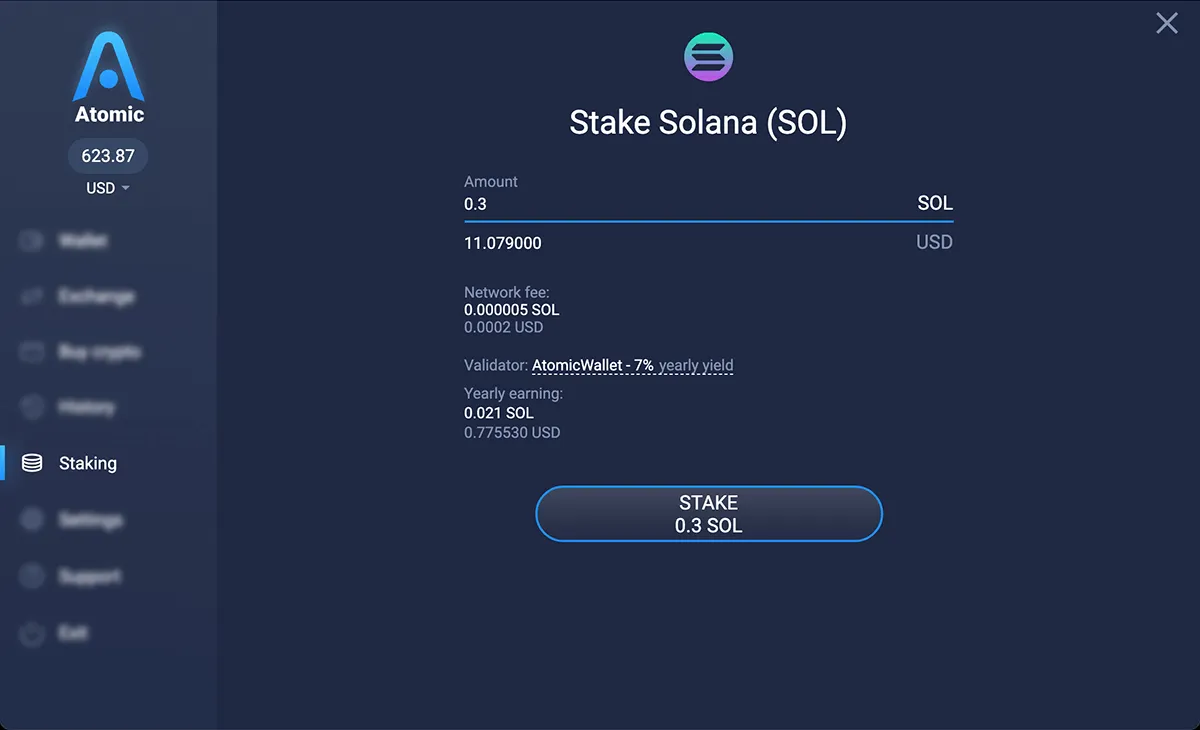
Enter the amount of SOL you wish to stake and confirm it, by entering your password. That's pretty much it! You have now officially started staking your Solana and are already earning rewards. Keep in mind, however, that SOL rewards take a bit of time to generate.
When will I get my staking rewards?
You'll receive your first staking rewards in 2 epochs after you start staking your SOL. It is important to remember, however, that the staking process itself is not simultaneous. It takes several epochs to get your funds staked in the first place. Since one epoch amounts to around 3 days, this means you'll see your first rewards roughly 6 days after your deposit was fully staked.
After that, you'll be earning rewards every epoch, that is, every 3 days.
How do I get my staking rewards?
One of the most convenient parts of staking Solana is that you don't have to claim your rewards manually, like Cardano, for example. You earn staking rewards and they are automatically added to your staked amount, increasing this amount and, by extension, the amount of rewards.
Unfortunately, because of this otherwise great feature, it is hard to track how many rewards you are actually getting. But worry not, the Solana foundation has thought it through. You can track your rewards on the Block Explorer.
How do I track my rewards?
Choose SOL from your coin list in Atomic Wallet (not your staking interface). Press the 'Receive' button and copy your SOL address. Go to Solana Beach, a SOL block explorer. Paste your address into the search bar.
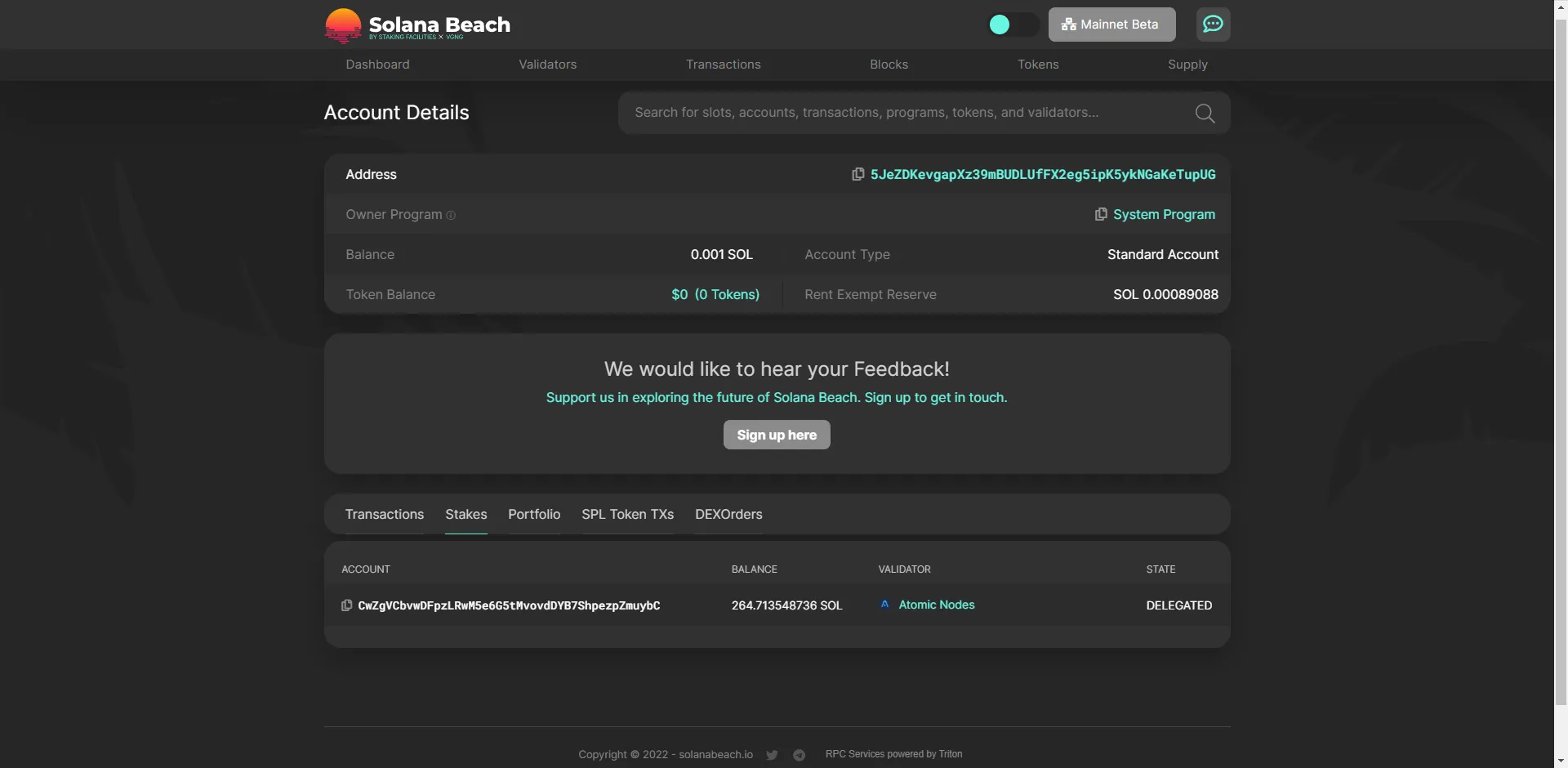
Scroll down a bit and find the 'Stakes' tab. You'll see your staking account. Solana creates one whenever you make a new stake, so you may see multiple stake accounts in this section. Select the one you want to check on and scroll down a bit. You'll find the 'Stake rewards' tab. Here, you'll see a by-epoch history of your staking rewards. Remember, that all rewards are added to your staking deposit, not your available SOL balance.
How do I unstake my SOL?
The process for unstaking your SOL is relatively simple and largely similar to the steps required when staking your assets in the first place. Once again we need to head back to the staking tab in the wallet interface and select SOL in the list. Hit the 'Unstake' button at the bottom of the screen.
Remember, if you had several delegations, i.e. you delegated funds several times and have several stake accounts, you will have to unstake each stake account individually. It is not possible to unstake all of your staked SOL at once. Select the stake account, enter the amount you want to unstake, and press 'Unstake'. ‘Unstaking’ is an available option at any time during the process, and you can end the agreement without forfeiting any of the rewards that you’ve garnered to date.
Remember, that unstaking takes several epochs, each lasting for around 3 days.
In several days, your SOL will appear under Available withdrawals. Just select 'Withdraw' to have your coins deposited to your SOL address.
What if I have more questions?
If you need an even more detailed guide on Solana staking, check out the article in our Knowledge Base, it really covers all of it!
If you do have any issues with either staking or unstaking your funds, you contact Atomic Wallet’s 24/7 customer support team (by reaching out directly through this online contact form).
Stake your Solana today!
Staking Solana is a straightforward process, that allows you to put your SOL tokens to good use and insure the security and stability of the blockchain. Staking yields great rewards, while also being beneficial to the entire network. Stake your Solana to help the blockchain and get some SOL rewards.










